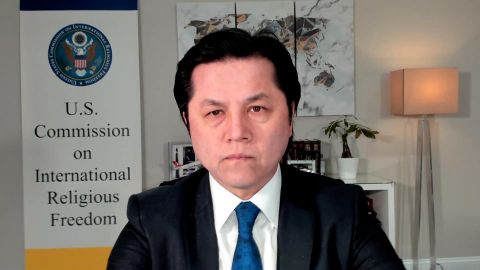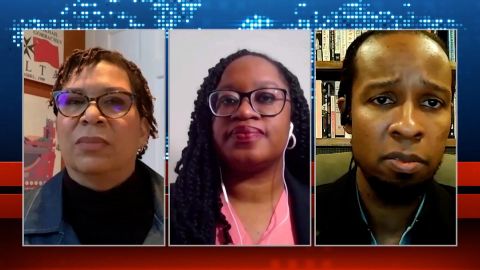Read Transcript EXPAND
CHRISTIANE AMANPOUR: Now, it is black history month in America. So, let us reach for the new book, “Four Hundred Souls: A Community History of African-America,” which was published this week. Written by award-winning historians, Keisha Blain and Ibram X. Kendi. it includes essays from many prominent black voices, including Angela Davis and Nikole Hannah Jones. Here are Blain and Kendi talking with our Michel Martin about why is it so important to you make a book a choral history?
MICHEL MARTI: Thank you, Christiane. Professor Kendi, Professor Blain, talking both so much for joining us.
KEISHA N. BLAIN, CO-EDITOR, “FOUR HUNDRED SOULS”: Thank you for having us.
IBRAM X. KENDI, CO-EDITOR, “FOUR HUNDRED SOULS”: Yes. Thank you.
MARTIN: You know, each of you has done sweeping large projects, but this is something else entirely. I mean, this is a collection of 80 writers, it includes journalists, historians and poets. Professor Kendi, you call this a communal diary. What do you mean by that and why this approach?
KENDI: Well, I mean, we really wanted to demonstrate the diversity of black America. And, you know, often times we’re seeing black folks I’ve seen monolith when we’re strikingly — we can very distinct. We — you know, there are, of course, people, different ethnic backgrounds, of course, gender, sexual orientations, regions, ages, and I think that’s represented in the text in terms of the contributors themselves, but even the history itself. And so — but I also think that it was important to not tell the same — to not write history in the same way where it is typically one person, usually a man, writing a history of the community. Why not bring together a community to write the history of a community.
MARTIN: Could I ask you to just give us a passage or two perhaps from one of your own essays that helps us to understand what this book is about and what you are trying to accomplish?
KENDI: So, I will share the final two graphs of the introduction that I wrote. There may be no better word to encapsulate black American history than community. For better or worse, ever since the 20 Ingogo (ph) people arrived, individuals of African-American descent have for the most part been made into a community, functioned as a community, departed the community, lived through so much as a community. I don’t know how the community has survived and at times thrived as much as it has been deprived for 400 years. The history of black America has been almost spiritual. Striving to survive the death that is racism. Living through death like spirits, forging a soulful history. The history full of souls. A soul for each year of history. Four hundred souls.
MARTIN: And Professor Blain, as I mentioned earlier, this doesn’t just have trained historians, people like yourselves, it has journalists, it has poets, it has political organizers writing pieces, often in very different voices. I just curious, Professor Blain, why that approach? Why these different kinds writers contributing to this kind of collection?
BLAIN: Well, we really wanted to capture the richness and the complexity of the history. And part of that meant having space to be creative. And I think, if we had a book with only, you know, professional historians, everyone might have approached their topic in similar way. But what’s nice about asking a philosopher to weight in or a journalist to weight in is that they are able to come to the topic through different lenses and through difference experiences and trainings. And I think, ultimately, we wanted the book to feel just that sense of community and that diverse community and we wanted each piece to be unique even though they were all connected thematically.
MARTIN: There are 80 writers and they’re all remarkable and they’re all different and go through, you know, 400 years of history, because let’s take turns and ask like which are some of the favorite essays?
KENDI: There are so many incredible pieces. But I will cheat and say, actually, the first piece in the text, Nikole Hannah-Jones’s essay on 1619 to 1624. And, of course, she is well-known for directing and conceiving of “The 1619 Project.” But her piece really sets the tone for this text. And what I mean by that is, it causes the reader to truly reimagine the arrival. It is — it has an extremely authoritative but simultaneously serious and complicated voice. You know, I am not speaking directly about what it is because it is so beautiful, I don’t want to give it away. But I think it really sort of sets the tone for the book.
MARTIN: The closing lines of her essay just chill me to my core. I mean, she says, the true story of America begins here in 1619. This is our story. We must not flinch. Professor Blain, what about you?
BLAIN: Well, one of my favorite pieces is actually written by Kiese Laymon who is a remarkable writer. And we asked him to write about cotton in the period of 1804 to 1809. And here is, I think, a very good example of what I meant when I said earlier about just the importance of bringing in a variety of voices into the narrative, because had we asked a professional historian to write about cotton, they would have been very frustrated with the 1804-1809 framework and they would say, well, there’s no way I can talk about cotton in just five years. I would have to talk about it maybe 20 or 30 or 40-year period or I need to do some broad analysis. And what Kiese was able to do is take the topic and connect it to his own personal narrative. And ultimately created a quiet remarkable piece. I think when I read it the first time, it took my breath away. And so, that’s one of my favorite pieces.
MARTIN: There are just some shocking stories there. I’m thinking about Herb Boyd’s essay, about the prevalence of slavery in New York, for example. He goes that there were more enslaved black in New York than in Tennessee in the early 18th century. He was tasked with writing about, you know, 1709 to 1714. There are well-known writers like Annette Gordon-Reed who writes — many people will know her work about Sally Hemings and authenticating that relationship between Sally Hemings and Thomas Jefferson. But she writes about just the psychological torture of having to navigate your own freedom and then the question of who gets left behind, who gets saved and who gets left behind? I mean, just something like remarkable thoughts here. Just pick some more.
KENDI: To me, one of my most favorite turns in the book is the — you know, part seven which begins with Adam Serwer who’s a — of course, a prominent columnist at “The Atlantic” writing on Frederick Douglass. And that being followed by Jamelle Bouie who writes on the civil war. And that essay being followed by Michael Harriot, who, of course, is from the root, writing on reconstruction. And these three writers, you know — I mean, for their respective publications, you know, it really doesn’t get any better than they do. And in their regular writing, they typically — even though as journalists, they typically use the lens of history to tell stories. And so, you know, those three, that trio of pieces were just a brilliant trio. And then, you keep moving, it’s Tara Hunter. You know, and so, it is — you know, it just really goes to show the breadth of the pieces in this text.
MARTIN: I noticed that there was a large number of women writing for this volume, and I wondered whether that was a happy accident or was that intentional?
BLAIN: Intentional.
MARTIN: Say more. And say more.
BLAIN: We felt very — in the very beginning, one of the things that we acknowledged was that generally when we read books on African-American history, and this is true for decades, we’re either reading a narrative by — you know, that’s written by a man and often times, we’re reading narratives that are ultimately framed by white historians. And so, part of what we wanted to do was to disrupt those two things, to intentionally make sure that every writer would be a person of African dissent. And then to make sure that we were prioritizing women in particular to disrupt that history, but also to send a larger message of the significance and the prominence of black women’s leadership and the history. And of course, we know this given everything that we have seen in last couple of years with just even, for example, the Black Lives Matter movement, and this powerful movement, you know, founded by three black women. So, part of it was making sure that we would this message by being intentional in the way that we selected the writers.
MARTIN: Professor Kendi, you referenced the opening essay line of Nikole Hannah-Jones who’s the kind of the creator and the creator vision behind “The 1619 Project, “The New York Times” project that also documented in its own way, it was a collection of essays documenting the sort of 400 years of the experience of people, the African-American descent in America. And, obviously, it was enormously well received by some people. You know, the printed text sold out several times, they had to go through several reprints. On the other hand, there’s been furious backlash to the project. The former president created this 1776 Commission to push for what he called patriotic education in part as a response to this project. I’m just wondering what you make of the intensity of response to that project, and perhaps to yours.
KENDI: Of course. So, I mean, I think it just goes to show how for many people or I should say, for too many people, they want to teach the history and they want to teach a current America that is not based in reality and it is not based in evidence and it is not based in fact. And their goal, they want people to learn history so they can “love America.” Not learn America, not know the truth about America, which then leads them to love or not love whatever feeling they have about their truth. And then they call a text like ours or other texts indoctrination without necessarily seeing the irony, you know, of what they are stealing, that indeed, they are trying to indoctrinate people to not know the truth, you know, but to sort of love, you know, a nation. I personally, you know, through my own work, I have experienced a tremendous amount of backlash, somehow advocating that we have a nation with policies that lead to equity and that we look upon different groups as equals, somehow that is anti-American or somehow, I am trying to indoctrinate people too, but it also — for me, it just shows less about me and more about the people saying that.
MARTIN: Professor Blain, thoughts?
BLAIN: Well, one of the things that I often think about is just the irony that those of us who write about racism will have people turn around and say, oh, you are actually the racist. You are the racist because you are pointing out social inequities. You are the racist because you’re trying to get others to see that something is wrong with the way that our society operates. And my sense is that people are always going to be uncomfortable when you ask them to step away from a particular point of view, a perspective that they have embraced. And even when that perspective is a racist one, they are not going to, you know, open up their hands and say, yes, I’m really to change. Sometimes that will happen but it’s a process. And so, I am not surprised by the backlash of “The 1619 Project,” because similar to our project, it was disrupting decades of narratives that so many people hold dear. And when you disrupt narratives, people get uncomfortable and they resist. And the hope is that more people will be open, more people will read, will listen and allow themselves to be transformed.
MARTIN: How do you respond to this argument by some, including some of your peers in the academy that this work is ideological, that it’s driven by sort of an ideology, that was the complaint by some fairly well-known historians to “The 1619 Project” and also to the 1776 Commission as well that — which was the creation of the former president? Do you engage that question? How do you respond to it?
BLAIN: Well, you know, history is political. It always has been. And as professional historians, we often debate this notion of objectivity. And it is a nice concept. And I do think it is important for us to be mindful of facts. And obviously, as historians, we want to make sure that we present accurate information. But what I also tell people is that we can’t put aside our own ideas and our own thoughts. You know, part of the critical analysis that we do as historians is to bring to bear our experiences. You know, our life experiences at times. And so, you know, as black scholars in the academy, we can’t simply talk about, for example, police violence in some abstract way, because this is something that affects all of us. It’s — you know, it’s a life and death issue for us. So, we can’t approach it without bringing our hearts to it, you know, as much as we bring our minds to it. So, I just think it’s important to recognize that throughout our history it’s always political, whether we’re talking about the Dunning School, you know, and we’re talking about this sort of narratives that tried to ignore black people’s agency. So, historians who say that it’s — you know, people are bringing their perspectives, well, yes, people have been doing that for decades.
MARTIN: I want to look back to where we started our conversation. I mean, Professor Kendi, you talked about this as a spiritual work in many ways and it’s also remarkable the history of African people, people with African descent in the United States. It’s remarkable on so many levels. It’s remarkable that they — we have survived and triumphed to the degree that we have. But yet, you dedicate the book to those lost by COVID, and what an interesting thing to reflect on in the moment. I just wonder what does that brings up for each of you?
KENDI: Well, I think for me, when we were thinking about this text, you know, we not only wanted to bring together this community, do something that’s never been done before in terms of writing of history, but we also recognize that this community of writers and this text could be picked up 100 years from now or 200 years from now, and people would be like, oh, so, this is what black folks, you know, in the United States were thinking about, this is how they were remembering their history. You know, for this to be like a sampling, you know, of what black folks were thinking. And then they will see the dedication that what black folks were essentially about to face in 2019, you know, was the racial pandemic within the viral pandemic. You know, and, indeed, just as this book is so beautiful, it was — around the corner was the ugliness of black people dying at twice the rates of white people from this pandemic, and it really just — to me, it encapsulates really the contradiction and that the book shows this incredible joy and pain.
MARTIN: Professor Blain, any final thoughts?
BLAIN: Well, I think, for us, it was impossible to complete this book and not be thinking about the ongoing challenges of COVID-19 as well as the uprising. Then, in fact, that as I was writing the conclusion, all of these things were on my mind and I felt like it was so important to acknowledge that even though we have made a lot of progress as a nation, even though we have so much to be proud of when we look at the experiences and the triumphs of black people in this country, we also needed to recognize that so many problems persist and the struggle still continues. It simply was impossible for us to avoid addressing these concerns given everything that we were experiencing and also the pain and the grief that we were dealing with individually and I think that collectively as a nation.
MARTIN: Professor Ibram X. Kendi, Professor Keisha Blain, thank you both so much for speaking with us.
BLAIN: Thank you for having us.
KENDI: Yes. Thank you.
About This Episode EXPAND
Bob Menendez; Nury Turkel; Viggo Mortensen; Ibram X. Kendi; Keisha N. Blain
LEARN MORE



